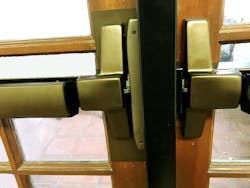Solution for Difficult Retrofit
Bryan Nicholas CML, of San Diego-based Door Systems Inc. needed to power the electric strike on a removable mullion. Years of real-world experience convinced the integrator that wires would be vulnerable. An inexperienced maintenance staff was likely to tear up the wiring harness assembly when taking the mullion down. So what to do?
Bryan had previously worked with Securitron’s Inductive Coupling Power Transfer for EAC applications and knew this would be a good solution.
How Wireless Power Transfer Works
Essentially, wireless power uses an alternating current to transmit energy across an open space. Alternating current energizes a wire coil, creating a magnetic field. This field then produces an alternating current in the receiving coil. [i] (End references will lead you to a plethora of technical papers, beyond the scope of this article.)
Close Coupled systems, like the Securitron device, produce rather efficient current transfer at limited range. This technology is now working well in numerous access control applications. The Inductive Coupling Power Transfer device (PowerJump®) produces six watts of continuous power. Higher current options are discussed below.
Resonant Circuits can also increase the range considerably, as does an increase in input frequency. In an unrelated development, the Wireless Power Consortium has developed the (Resonant Circuit) Qi standard (pronounced “chee”) which has been adopted for cell phone and notepad charging over distances up to 1.6 inches.
In addition to access control, a number of other applications are being developed, including electric vehicle charging, industrial power, and many others. Auckland, New Zealand company, Power by Proxi, currently has ICPT products delivering from 12 to 150 watts in commercial use.[ii] (Ibid).
History
During the 1800s, work by Ampere, Faraday, Maxwell, and Hertz developed electromagnetic theory and led to the discovery of radio waves. [iii]
Serbian-American inventor and engineer Nikola Tesla went on to demonstrate wireless energy transmission with resonant transformers known as Tesla Coils. [iv] A long-range demonstration project was actually attempted in 1901 using Resonant Inductive Coupling. RFID tag experiments began in the 1970s and in the 2000s professors Hui and Tang developed resonant chargers for small electronics.
“Today, wireless power is used for everything from industrial motors to charging smartphones and tablets.” [v] Other applications are beginning to emerge, with considerable interest in Electronic Access Control (EAC), industrial processes, and transportation.
Access Control Market Needs
Although door loop cords and electric hinges were well developed, applying power to electrified locks and exit devices still offers challenges. Core drilling issues, the need for specialized tools, esthetics, preserving fire ratings, and fragile connectors have led several to explore Inductive Coupling Power Transfer as an option for swinging or sliding doors. Until now, physical size restraints, installation quality, and the need for EAC data transfer have inhibited the application of wireless power transfer in the EAC industry.
Providing power to removable mullions has been a particularly vexing problem. Some early attempts at wirelessly powering these movable parts were sidetracked when installation consistency proved challenging.
Former HES electric strike manufacturer Lee Hanchett had been watching the growth of wireless power, more properly called Inductive Coupling Power Transfer. Existing magnetic coil, potting, and electrical engineering expertise convinced Hanchett and Securitron management that this technology was well within their field of expertise.
The engineering team began to explore wireless power options for access control applications. They found it could get very complicated. A case in point: Wikipedia cites 133 references under the title “Wireless Power Transfer.” (See endnotes below). Quite a number of technical articles like the one from the University of Alexandria by Hassan and Elzawawi on Wireless Power Transfer through Inductive Coupling appear to be rapidly advancing the knowledge base.[vi]
By 2014, Securitron introduced the PowerJump ICPT product. Integrator Bryan Nicholas was confident that this was a good solution for his removable mullion problem. Multiple installations have proved this to be a solid solution.
PowerJump Design Criteria
Commercial products up to 150 watts are available from Power by Proxi in New Zealand. Cost and size currently preclude their concealed use in swinging or sliding door applications. On the other hand, recent developments in energy efficiency have dramatically reduced the current required to unlock most door hardware.
Although higher frequency transmission can increase current, the added cost did not justify more than six watts of power (500 mA @ 12VDC or 250 mA @ 24 VDC). Where more power has been needed, two PowerJump coils have been installed in close proximity with no power degradation. Capacitors can be applied to increase start-up current when required. Efficiency tends to run in the upper 90 percent range with no heat build-up in intermittent use.
Several additional design issues were considered. The first was durability. Design endurance is for 2,000,000 cycles. Structurally sound potting is designed to withstand +/- 150 psi, and is ANSI/SDI-BHMA Windstorm Listed. The product is FCC Part 15 compliant. One critical issue for the access control industry is what happens when the door sags. The PowerJump product is designed to deliver full power across gaps of up to 3/16”. Normal vertical alignment sagging can be accommodated with no significant power loss. [vii]
Extensive laboratory work verified the validity of the ICPT concept, and beta field test ensued. Technical staff at San Diego integrator Door Systems, Inc., worked out frame mounting details for removable mullions with the creative use of a 3-D printer. During numerous removable mullion installations, the integrator worked with Securitron to produce a pre-packaged removable mullion kit that allows easy installation in the mullion and header assembly. A number of other real-world beta field tests also helped Securitron refine the system into a rather bulletproof product.
The result is a well-documented and simple installation process. Clear instructions, good templates, and an included install kit with screws, shims, and tabs ensure a solid fit. Maintenance staff can now remove the mullion and re-install without even knowing a power connection existed.
Since power is switched upstream at the power supply, there is no current flow (or heat) across the air gap until activation. Capacitors can be used to energize larger devices, with no visible time lag. Although continuous duty power transfer is certified and practical, surface heat near a lock can be disconcerting to users.
Additional Applications
One pleasant surprise came when installers advised that the ICPT provided an exceptionally easy means to provide power to aluminum channel storefront doors. Since the channel is hollow, it was a simple task to drop a wire from the ICPT power source on the header to an electrified lock or exit device.
Since an ICPT device can be mounted anywhere on the door, power can be routed from any position on the frame, directly to the lock with no other door prep. In some cases, the PowerJump has been embedded in continuous hinges. Other developments are in the works to further enhance the utility of the technology.
Corrosive and explosive environments appear to be promising applications since the inductive coupling device is potted. And then there’s the problem of battery life in hotel guestroom locks. Every guest has had at least one (or several) dead-battery lockouts. Of course, the maintenance staff is always busy replacing dead and dying batteries. Some see ICPT technology as a viable solution for this problem.
Since electrified locksets that communicate with host controllers generally use wires to communicate, the electrified hinge has remained the conventional installation standard. Bluetooth and other RF technologies are sure to stimulate a reassessment of this process. The Power by Proxi company already has a number of applications with wireless power and data.
So far, Securitron is the only player we’ve been able to locate in the North American access control market, although a Korean startup demonstrated a working model at the 2017 ISC West show in Las Vegas. It is probably a lot easier for other OEMs to use this existing PowerJump product than spending precious R&D resources on reinventing the wheel.
Is Inductive Coupling Power Transfer a Disruptive Technology?
It probably is. The technology did lay dormant for nearly 100-years, but it appears to be picking up speed. ICPT is probably not yet the integrator’s silver bullet, but it already charges your cell phone, is charging electric cars, powering locks and electric strikes, industrial applications, and will likely become as ubiquitous as the smartphone.
About the Author: Cameron Sharpe, CPP worked in marketing for Caterpillar and Honeywell before serving 25-years with Best Lock Corporation in New Jersey and Arizona. “It is always a pleasure to watch a real professional like Nicholas, who knows what he’s doing, and takes pride his work.”
Attributions
[i] Wireless Power & How it Works: A brief history. https://powerbyproxi.com/wireless-power
[ii] Ibid.
[iii] Wireless Power Transfer – Wikipedia. https://en.wikipedia.org/wiki/Wireless_power_transfer#History
[iv] “Wireless Power Transfer through Inductive Coupling.” http://www.inase.org/library/2015/zakynthos/bypaper/CIRCUITS/CIRCUITS-18.pdf
[v] Wireless Power & How it Works: A brief history. https://powerbyproxi.com/wireless-power
[vi] “Wireless Power Transfer through Inductive Coupling.” http://www.inase.org/library/2015/zakynthos/bypaper/CIRCUITS/CIRCUITS-18.pdf
[vii] Securitron ICPT PowerJump®. http://www.securitron.com/en/site/securitron/products/power-transfers/icpt-inductive-coupling-power-transfer/



